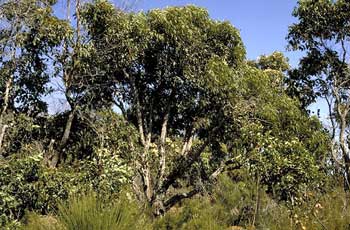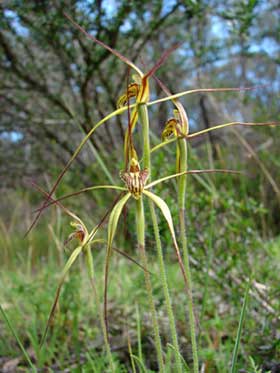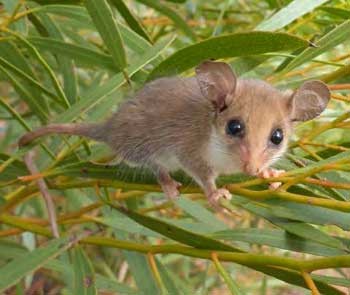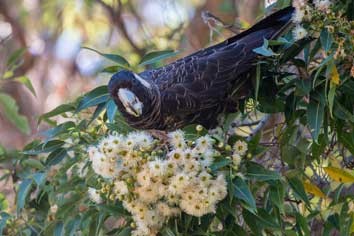Biodiversity
Flora & Vegetation
Meelup Regional Park lies within the Southwest Botanical Province, recognised as a global biodiversity hotspot. The Park’s vegetation is of extremely high conservation value and ranges from jarrah and marri forests, banksia woodlands, coastal heath, low shrublands, annual herbs, grasses and orchids.
The diversity of habitat within the Park has resulted in a significant range of vegetation and a rich diversity of flora, much of which is not represented elsewhere within the Leeuwin Block major landform. Over 600 plants species have been recorded in the Park to date, including a Threatened Ecological Community - Calothamnus graniticus subsp graniticus coastal heath, 12 threatened or priority listed flora and several species that are endemic (unique) to the Park.
The vegetation complexes of the Park are poorly represented in other conservation reserves. The Park supports almost 50% of the remaining extent of the Wilyabrup vegetation complex; this highly restricted complex is associated with expressions of granite in the Margaret River Plateau extent of the Leeuwin Block major landform. All occurrences of this complex support significant populations of endemic and disjunct flora, of which occurrences in Meelup are the largest and the richest (Webb, 2012).
While spring is the best time to see wildflowers in the Park, there are flowering plants at all times of the year. For more information about the flora of the Park, see the Flora of Meelup Regional Park website, pick up a Wildflowers brochure at local visitor centres or by contacting the Friends of Meelup Regional Park, or refer to ‘The Flora and Vegetation of the Meelup Reserve System’ (Webb 2012).
A field guide to the wildflowers of Meelup Regional Park can be found at local visitor centres or by contacting the Friends of Meelup.
Spotlight on Flora
Meelup Mallee Eucalyptus phylacis
DID YOU KNOW?
The Meelup Mallee is only found in Meelup Regional Park, growing in loamy granitic and lateritic soils. The population of this mallee is estimated to be fewer than 50 individuals.
Research has shown that the entire population of this mallee is a clone and therefore a single plant. The plant is potentially up to 6,600 years old and one of the oldest eucalyptus on record.
The Mallee grows to approximately 5m tall and blooms in February showing a display of white flowers.
Insect damage, aerial canker, inappropriate fire regimes, poor genetic diversity, poor regeneration and road maintenance are threats to this species.
The 'Meelup Mallee Interim Recovery Plan' (280.6KB) has detailed information about this species.


Cape Spider Orchid Caladenia caesarea spp. maritima
DID YOU KNOW?
The Critically Endangered Cape Spider Orchid is only known from six populations, all of which are in Meelup Regional Park. The orchids flowers from August to December and only grows in shallow pockets of red-brown sandy loam on coastal granite outcrops.
The 'Cape Spider Orchid Recovery Plan' has detailed information about this species.
Fauna
As a coastal reserve isolated by farmland and urban development, Meelup Regional Park is an island ark for fauna. The significant range of ecosystems, from granite outcrops to creeklines, provide habitat to wide range of fauna. Species of conservation significance that are found in the Park include:
- Southern brown bandicoot or Quenda, Isoodon fusciventer, Priority 4
- Western ringtail possum or Ngaren (Ngwayir), Pseudocheiris occidentalis - Critically Endangered
- Western false pipistrelle bat, Falsistrellus mackenziei, Near Threatened
- Carnaby’s black cockatoo or Ngoorlak, Zanda latirostris, Endangered
- Baudin’s black cockatoo or Manitj, Zanda baudinii, Endangered
- Forest red-tail black cockatoo or Karrak, Calyptorhynchus banksii naso, Vulnerable
A fauna survey in 2014 by NGH Environmental (6.35MB) found a total of 102 fauna species (excluding fish and invertebrates).
Spotlight on Fauna
WESTERN PYGMY POSSUM Cercartetus concinnus
DID YOU KNOW?
Pygmy possums are marsupials, which means mothers raise their young in a pouch. They are nocturnal and have a tail covered in scales! These possums love pollen and nectar and can enter torpor (a sleep-like state) when it is too cold. This allows them to save energy.


BAUDIN’S BLACK COCKATOO Zanda baudinii
DID YOU KNOW?
Baudin’s black cockatoos can live for up to 50 years in the wild and will mate for life. They eat the seeds from marri, banksia, hakea and jarrah trees. They require hollows in old growth trees to breed; trees must be 150yrs old before they form these hollows!
(Source DBCA 2018, nth 2014)
Image by: Mark Oliver